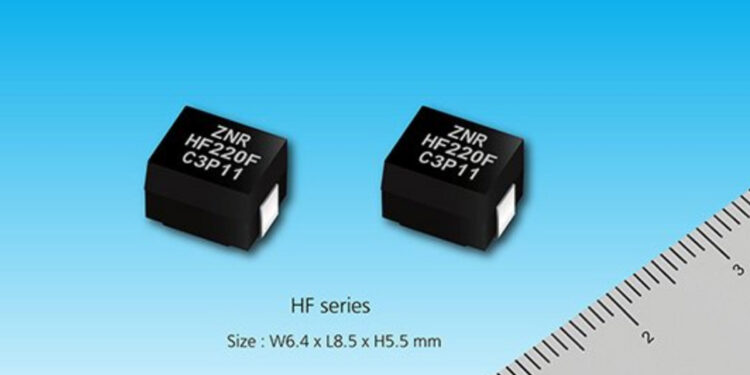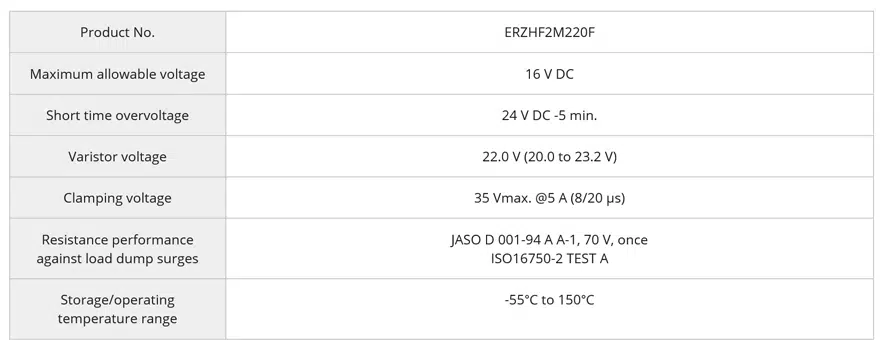Panasonic releases high energy varistors for protecting automotive ECUs from load dump surges. The new varistors achieve the industry’s highest level of heat resistance of 150℃.
Panasonic Corporation announced that its Industry Company has commercialized ZNR[1] high energy varistors[2], which protect ECUs (electronic control units) from load dump surges[3] of automobiles. The mass production will start in March 2022.
The rise in environmental and safety awareness has led to progress in the digitization and electrification of automobiles including motorcycles, increasing the number of ECUs mounted. More ECUs are mounted in the vicinity of heat generating parts such as engines, increasing the demand for heat resistance of protective devices against load dump surges.
Panasonic successfully developed and commercialized the world’s first ZnO varistor (zinc oxide varistor) in 1968. By utilizing the varistor technology it developed over the years since, the company has commercialized ZNR high energy varistors suitable for a wider range of automotive applications, as part of its efforts to improve the heat resistance of varistors for load dump surge protection.
Panasonic’s new ZNR® high energy varistors have the following features:
- Their unique structure achieves both bending strength and the industry’s highest level of heat resistance temperature of 150℃.
- Excellent product characteristics (resistance performance against load dump surges, clamping voltage[4]) protect automotive ECUs from surges.
- The reduced size and weight save space and lower environmental load.
Recommended applications:
Load dump surge protection for automotive ECUs, etc.
(ECUs for lighting, engine control, and electronic meters, as well as USB chargers, etc.)
Product features:
1. Their unique structure achieves both bending strength and the industry’s highest level of heat resistance temperature of 150℃.
With an increase in the number of ECUs mounted in the vicinity of heat generating parts such as engines, automotive applications now require varistors with a higher heat resistance. However, as single components, conventional varistors are susceptible to rapid heat stress due to temperature changes although their resin mold structure makes them resistant to the deflection stress of the board. This necessitated the restriction of their operating temperature range to -40℃ to 125℃. By applying its material and structure design technologies accumulated through the development of various high heat-resistance devices, Panasonic has significantly reduced stress due to temperature changes, achieving the industry’s highest operating temperature range of -55℃ to 150℃ (Panasonic’s previous product: -40℃ to 125℃).
2. Excellent product characteristics (resistance performance against load dump surges, clamping voltage) protect automotive ECUs from surges.
The newly developed varistors provide excellent protection performance for automotive ECUs against surges due to their resistance performance against load dump surges that complies with the international standard ISO16750-2 and JASO D 001-94 Type A A-1[5] related to automotive load dump surges, as well as by achieving the industry’s lowest* clamping voltage of 35 Vmax.
- * As ZnO varistor products (as of March 25, 2022, Panasonic data)
3. The reduced size and weight save space and lower environmental load.
The newly developed varistors are compact with dimensions of 6.4 mm (W) × 8.0 mm (L) × 5.5 mm (H), enabling the reduction of the mounting area and weight to a half or less compared to Zener diodes[6] with equivalent performance, thereby contributing to the reduction of the amount of environmentally hazardous substances used.
Basic specifications:
Term Descriptions:
[1] ZNR. ZNR, which is a registered trademark of Panasonic Corporation, refers to a voltage-dependent ceramic resistor (varistor) that is mainly made of zinc oxide and changes its resistance value depending on the applied voltage. ZNR won the One Step on Electro-Technology electrical technology award (The Institute of Electrical Engineers of Japan) in 2018.
[2] Varistor. Varistor, whose name originates from variable resistor, refers to a non-linear resistance element. The world’s first ZnO varistor (zinc oxide varistor), which Panasonic successfully developed and commercialized in 1968, revolutionized overvoltage protection technology against lightning surges, etc., contributing to the development of an advanced-information and energy society.
[3] Load dump surge. A surge generated when the battery connection is lost while an automotive engine is in operation and the alternator is charging the battery.
[4] Clamping voltage. Clamping voltage refers to the voltage suppressed by the varistor when a surge voltage is applied. A standard impulse current waveform (8/20 μs) is applied to determine the voltage across the varistor terminals.
[5] JASO D 001-94 Type A A-1. A 12-V system transient voltage test specified in the General Rules of Environmental Testing Methods for Automotive Electronic Equipment stipulated by the Society of Automotive Engineers of Japan, Inc. Abolished in March 2010.
[6]Zener diode. A semiconductor element that is a type of diode. Also referred to as a constant voltage diode. Zener diodes are also used for surge and noise protection.



































